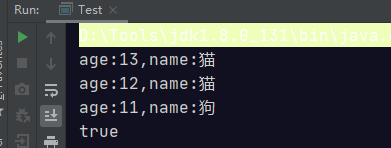标签:put 逻辑 对象 一个 性能 anim private -128 else
定义:
? 运用共享技术来有效地支持大量细粒度对象的复用。它通过共享已经存在的对象来大幅度减少需要创建的对象数量、避免大量相似对象的开销,从而提高系统资源的利用率。
享元(Flyweight )模式中存在以下两种状态:
享元模式的主要有以下角色:
代码如下:
/**
* @author WGR
* @create 2021/1/13 -- 21:11
*/
public abstract class Animal {
public abstract String getName();
public void getInfo(Integer age){
System.out.println("age:"+age+",name:"+getName());
}
}
/**
* @author WGR
* @create 2021/1/13 -- 21:18
*/
public class Cat extends Animal {
@Override
public String getName() {
return "猫";
}
}
/**
* @author WGR
* @create 2021/1/13 -- 21:20
*/
public class Dog extends Animal {
@Override
public String getName() {
return "狗";
}
}
import java.util.Map;
import java.util.concurrent.ConcurrentHashMap;
/**
* @author WGR
* @create 2021/1/13 -- 21:25
*/
public class AnimalFactory {
private static Map<String,Animal> animals = new ConcurrentHashMap<>();
public static Animal getAnimal(String key){
Animal animal;
if(!animals.containsKey(key)){
if("猫".equals(key)){
animal = new Cat();
}else{
animal = new Dog();
}
animals.put(key, animal);
}
return animals.get(key);
};
}
测试代码:
/**
* @author WGR
* @create 2021/1/13 -- 21:34
*/
public class Test {
public static void main(String[] args) {
Animal cat1 = AnimalFactory.getAnimal("猫");
Animal cat2 = AnimalFactory.getAnimal("猫");
Animal dog = AnimalFactory.getAnimal("狗");
cat1.getInfo(13);
cat2.getInfo(12);
dog.getInfo(11);
System.out.println(cat1 == cat2);
}
}

1,优点
2,缺点:
为了使对象可以共享,需要将享元对象的部分状态外部化,分离内部状态和外部状态,使程序逻辑复杂
3,使用场景:
Integer类使用了享元模式。我们先看下面的例子:
/**
* @author WGR
* @create 2021/1/13 -- 22:00
*/
public class Demo {
public static void main(String[] args) {
Integer i1 = 127;
Integer i2 = 127;
System.out.println("i1和i2对象是否是同一个对象?" + (i1 == i2));
Integer i3 = 128;
Integer i4 = 128;
System.out.println("i3和i4对象是否是同一个对象?" + (i3 == i4));
}
}

为什么第一个输出语句输出的是true,第二个输出语句输出的是false?通过反编译软件进行反编译,代码如下:
public class Demo {
public static void main(String[] args) {
Integer i1 = Integer.valueOf((int)127);
Integer i2 Integer.valueOf((int)127);
System.out.println((String)new StringBuilder().append((String)"i1\u548ci2\u5bf9\u8c61\u662f\u5426\u662f\u540c\u4e00\u4e2a\u5bf9\u8c61\uff1f").append((boolean)(i1 == i2)).toString());
Integer i3 = Integer.valueOf((int)128);
Integer i4 = Integer.valueOf((int)128);
System.out.println((String)new StringBuilder().append((String)"i3\u548ci4\u5bf9\u8c61\u662f\u5426\u662f\u540c\u4e00\u4e2a\u5bf9\u8c61\uff1f").append((boolean)(i3 == i4)).toString());
}
}
上面代码可以看到,直接给Integer类型的变量赋值基本数据类型数据的操作底层使用的是 valueOf() ,所以只需要看该方法即可
public final class Integer extends Number implements Comparable<Integer> {
public static Integer valueOf(int i) {
if (i >= IntegerCache.low && i <= IntegerCache.high)
return IntegerCache.cache[i + (-IntegerCache.low)];
return new Integer(i);
}
private static class IntegerCache {
static final int low = -128;
static final int high;
static final Integer cache[];
static {
int h = 127;
String integerCacheHighPropValue =
sun.misc.VM.getSavedProperty("java.lang.Integer.IntegerCache.high");
if (integerCacheHighPropValue != null) {
try {
int i = parseInt(integerCacheHighPropValue);
i = Math.max(i, 127);
// Maximum array size is Integer.MAX_VALUE
h = Math.min(i, Integer.MAX_VALUE - (-low) -1);
} catch( NumberFormatException nfe) {
}
}
high = h;
cache = new Integer[(high - low) + 1];
int j = low;
for(int k = 0; k < cache.length; k++)
cache[k] = new Integer(j++);
// range [-128, 127] must be interned (JLS7 5.1.7)
assert IntegerCache.high >= 127;
}
private IntegerCache() {}
}
}
可以看到 Integer 默认先创建并缓存 -128 ~ 127 之间数的 Integer 对象,当调用 valueOf 时如果参数在 -128 ~ 127 之间则计算下标并从缓存中返回,否则创建一个新的 Integer 对象。
标签:put 逻辑 对象 一个 性能 anim private -128 else
原文地址:https://www.cnblogs.com/dalianpai/p/14274707.html